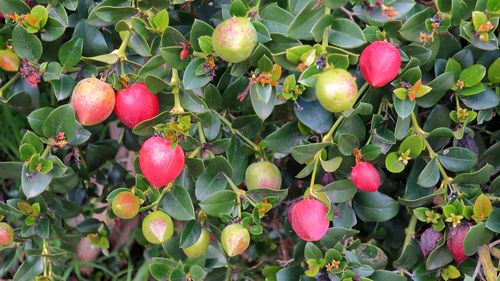The num num is a beautiful and useful plant native to South Africa. In the Zulu language, a language spoken by more than nine million people mostly in South Africa, this plant is called amatungulu. It can be found in Southern Africa and all along the Eastern coast of Africa, including in countries like Mozambique and Kenya.
The num num is a sturdy plant that grows well in coastal areas. This plant can handle salt air and strong winds, making it a perfect plant to grow near sand dunes or coastal forests. The num num can grow without much rain. The plant does not do well in cold or freezing environments, though. It has shiny, green leaves and white, star-shaped flowers. At night, the flowers produce a sweet smell. Butterflies and honeybees feed off the nectar in the flowers, pollinating the plants.
In warm climates, num num plants produce red fruits from March to October. Num num fruits are oval-shaped and smaller than a ping-pong ball. The seeds inside the fruit are soft and edible. When cut, these fruits release a white, sticky milk. Monkeys and birds love to enjoy their sweet fruity flesh. But animals and fruit pickers beware! The thorns on the plant stems can be quite sharp! Once picked off the thorny stem, people eat these fruits raw or make pies, jams, jellies, and sauces.
These fruits offer more than just a tasty snack. Num num fruits are rich in Vitamin C, calcium, magnesium and phosphorus. These nutrients help strengthen bones and boost a person’s immune system to keep them healthy. The num num plant also has medicinal uses. Indigenous people from South Africa also use the roots to treat toothaches.
Num num fruits are nutritious sources of food. Researchers have studied the positive impact growing more num num plants and other native edible plants could have on certain African communities. Currently, some people in these local communities rely on a very small number of food species (including wheat and corn) to get their nutrients. Many of these foods are not as nutritious as the num num fruit. Growing more num num plants and other native plants could promote food diversity in these communities. Some scholars hope that communities will learn more about the num num plant’s benefits and bring more of these nutritious and delicious fruits into their diets.









